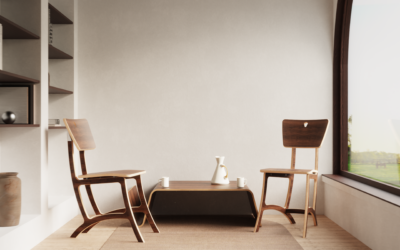
What is 3D Rendering?
3D rendering is the process of creating realistic visuals from 3D models. For architecture, 3D models capture the smallest details of a building’s interior, exterior, and associated structure and systems. 3D rendering takes it further to help convey how a building will appear in its immediate environment with accurate lighting, materials and textures. Britannica defines architectural rendering as the “branch of the pictorial arts and of architectural design whose special aim is to show, before buildings have been built, how they will look when completed.” First, the geometry is modeled with 3D modeling software that may be separate or integrated with the 3D rendering software.
What is 3D Rendering Software?
3D rendering software provides the ability to apply materials, textures, and lighting to a 3D model. 3D rendering software often links to the 3D modeling software to import the model directly. The best 3D rendering applications make this very easy, importing each part with the correct features in the correct order. Its purpose is to make the process of creating photorealistic visuals fast, easy, and accurate. From floors and ceilings to space and lighting, architectural rendering software allows you to create visuals that communicate size, scale, and appearance to clients. And the 3d rendering market is growing fast from more adoption in architecture, construction, and real estate driving demand. With that, and customer expectations rising, it makes sense to know what to consider when looking for the best 3D rendering software for architecture.
The Best 3D Rendering Software for Architectural Visualization: What to Consider

Photorealistic Rendering Quality
Quality is at the top of the list for architectural visuals. The best 3D rendering software produces exceptionally realistic and high-quality visuals. Additionally, it should simulate real-world lighting, materials, and textures, while maintaining accuracy, to generate visuals that are indistinguishable from photographs or video.
Real-Time Rendering
The best rendering software offers real-time rendering capabilities. This allows you to make changes to the scene and see the results instantly. It should offer real-time rendering for both CPU and GPU and the ability to adjust the utilization of each. Real-time rendering is invaluable for material and lighting exploration, as well as client presentations.
Extensive Material Library
A key differentiator of 3D rendering software is their library of preset materials, colors, textures, environments, and lighting. A library saves time by providing a variety of assets for creating realistic surfaces, such as wood, glass, metal, and fabrics. It should also allow the ability to have a network drive of materials so everyone can access the same materials to create consistent visuals.
Advanced Material Customization and Creation
Along with a variety of materials, the best 3D rendering software should provide the ability to customize the materials or create completely new materials. It should allow complex texture layering, procedural geometry, multi-material capabilities, and a method to save and share materials with others.
Advanced Lighting Creation and Control
The software should also offer advanced lighting creation and control, including the creation and adjustment of physical lighting. It should also incorporate real-world qualities of light. Global illumination, sun and sky settings, and HDRI (High Dynamic Range Imaging) creation and editing are features that help achieve realistic lighting both inside and outside the building.
Integration with 3D Modeling Software
Good 3D rendering software will have seamless integration with the most popular 3D modeling software like Autodesk Revit, SketchUp, Rhino, and others. Tight integration allows you to easily transfer 3D models to the rendering software without issues while maintaining a link to update any changes to geometry.
User-Friendly Interface
The best rendering software has an intuitive and user-friendly interface with the option to customize it to match your workflow. Each window, tab, section, and button should be easy to navigate and understand. The ability to customize and save interface layouts can help you get started quickly or have different layouts for a specific 3D rendering task.
Powerful Rendering Engine
The rendering engine is the brain of the rendering software. It takes all the parameters entered to generate the visual. It should be capable of rendering complex materials and lighting conditions and work efficiently with the hardware to generate the 3D rendered visual quickly. A software company that develops their own rendering engine brings a higher level of understanding and support.
Realistic Camera Settings
The camera is what captures the composition and everything you have added to the scene. The software should offer a list to save different camera views and along with architectural specific features like tilt-shift, perspective matching, and walkthrough mode along with the ability to set Depth of Field as you would on a real-world camera.
VR/AR/Web Output
The best 3D rendering software allows the output of all types of 3D visuals, not only images and video. Additionally, the software should let you generate VR (virtual reality)/AR (augmented reality) experiences and visuals that can be shared and viewed online. This can be beneficial for immersive presentations and walkthroughs of both site and building.
Are There Other Factors to Consider?

Efficient Workflow
The software should offer tools and features that streamline the rendering process, such as model and scene variations, geometry tools, as well as region and batch rendering.
Robust Documentation and Support
Quality software provides extensive documentation, tutorials, and a responsive support team to assist you with any issues or questions.
Cost-Effectiveness
While professional 3D rendering software may come at a premium price, it should offer excellent value for the features and capabilities it provides. Consider the return on investment and how the software improves your workflow and final output.
Regular Updates and Development
Top software is under active development with regular updates and improvements to keep up with industry trends and user needs.
Community and Resources
A strong user community and online resources reveal a software’s popularity and its ability to support users effectively.
Performance Optimization
Leading software is optimized to take advantage of modern hardware, including multi-core CPUs and powerful GPUs, to deliver faster rendering speeds.
Is KeyShot the Best for Architectural 3D Rendering?
The best 3D rendering software for architecture that checks off all the items above is KeyShot. Offering a combination of cutting-edge rendering technology, accessibility, and ease of use, it allows you to create architectural visuals with the speed and accuracy you expect. Architects and architecture firms around the world use KeyShot across the project development process to capture the detail generated in the 3D model and communicate the appearance of the unique material and lighting desired by the client. The designer can use Mac or PC to build out scene variations and present them to the client with images, animation, in VR/AR or on the web. Even more, the capabilities in KeyShot are compounded by its rich data and asset management that allows individuals and firms to develop visuals that are consistent while prioritizing speed.






0 Comments